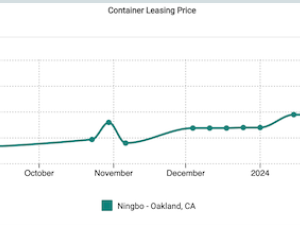'After demand growth of more than 15% in 2010, we expect further growth in the 7-8% range for 2011,' said Y.M. Kim, President and CEO of Hanjin Shipping Co. 'This continued cargo growth, from a much higher base, is in our view a very positive sign of recovery.' Mr, Kim noted that cargo activity is somewhat quieter than expected in the run-up to Lunar New Year holiday factory closures in Asia. But he added that 'advance bookings and market data suggest a return to robust trade flows by late spring and early summer, with a possibility that vessel space and equipment will be tight at times leading into the peak season.'
TSA noted 2011 industry forecasts of 8.8% growth in Transpacific capacity and added that delays on new vessel deliveries, heavy demand for ships on Intra-Asia routes and other factors will temper the impact of that growth as well. Reinvesting in carrier service networks to meet demand growth and serve customers' specialized needs, the Agreement said, makes its recommended program of adjustments to rates and charges all the more critical.
'All of us had to hit the ground running in early 2010 ' climbing out of the deepest global recession in decades, redeploying assets and restoring services,' Mr. Kim pointed out. 'Carriers rushed to fill ships, did not always get their pricing right, and at times alienated valued customers as they struggled to recover. Our focus in 2011 must now be to rebuild relationships, based on reliable services at fair, stable prices. Our aim is to stabilize rates and avoid the dramatic peaks and valleys that have characterized the trade for the last several years.'
TSA's internal reporting indicates that Q4 2010 carrier vessel utilization was higher than that portrayed in recent analyst or press reports, and were typical for the onset of the traditional post-holiday winter season.' Average West Coast utilization among TSA's 15 members, for example, ranged from a high of 96% in late October to a low of 79% in early December.' East Coast utilization ranged from 94% in early October to 84% at the end of November. Utilization in early January 2011 was 88% to the West Coast and 95% to the East Coast.
'We expect overall 2011 load factors to remain quite strong,' TSA executive administrator Brian M. Conrad predicted. 'Even if there prove to be dips in utilization levels during certain periods, the experience of early 2010 is still relatively fresh in carriers' minds. Each carrier faces clearly defined costs in shore side labor, equipment, inland transportation, debt service, documentation and so on. Knowing those costs, managing them effectively and keeping rates at compensatory levels will be critical to any carrier's long-term competitive position in this trade.'
He added that container equipment may also be in short supply this summer, placing constraints on effective capacity across carrier networks. TSA lines estimate that container manufacturing facilities in Asia are operating at roughly half their peak 2008 production levels of 3.5 million units annually, and will reach close to 3 million units by the end of 2011.
TSA is a research and discussion forum of major container shipping lines serving the trade from Asia to ports and inland points in the U.S. More information on TSA can be found at www.tsacarriers.org.
TSA members include:
APL Ltd.; Kawasaki Kisen Kaisha, Ltd. (K Line)
China Shipping Container Lines; Maersk Line
CMA-CGM; Mediterranean Shipping Co.
COSCO Container Lines, Ltd; Nippon Yusen Kaisha (N.Y.K. Line)
Evergreen Line; Orient Overseas Container Line, Inc




